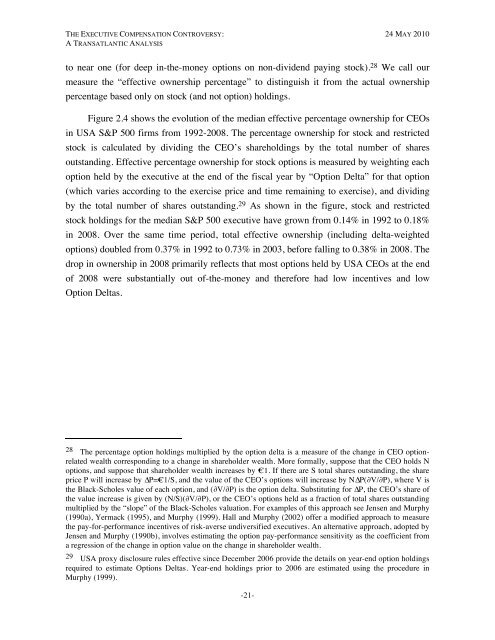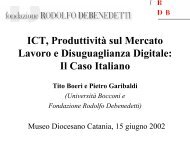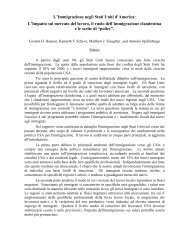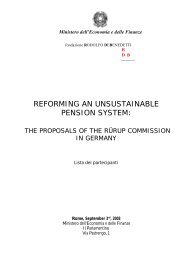The Executive Compensation Controversy - Fondazione Rodolfo ...
The Executive Compensation Controversy - Fondazione Rodolfo ...
The Executive Compensation Controversy - Fondazione Rodolfo ...
You also want an ePaper? Increase the reach of your titles
YUMPU automatically turns print PDFs into web optimized ePapers that Google loves.
THE EXECUTIVE COMPENSATION CONTROVERSY: 24 MAY 2010A TRANSATLANTIC ANALYSISto near one (for deep in-the-money options on non-dividend paying stock). 28 We call ourmeasure the “effective ownership percentage” to distinguish it from the actual ownershippercentage based only on stock (and not option) holdings.Figure 2.4 shows the evolution of the median effective percentage ownership for CEOsin USA S&P 500 firms from 1992-2008. <strong>The</strong> percentage ownership for stock and restrictedstock is calculated by dividing the CEO’s shareholdings by the total number of sharesoutstanding. Effective percentage ownership for stock options is measured by weighting eachoption held by the executive at the end of the fiscal year by “Option Delta” for that option(which varies according to the exercise price and time remaining to exercise), and dividingby the total number of shares outstanding. 29 As shown in the figure, stock and restrictedstock holdings for the median S&P 500 executive have grown from 0.14% in 1992 to 0.18%in 2008. Over the same time period, total effective ownership (including delta-weightedoptions) doubled from 0.37% in 1992 to 0.73% in 2003, before falling to 0.38% in 2008. <strong>The</strong>drop in ownership in 2008 primarily reflects that most options held by USA CEOs at the endof 2008 were substantially out of-the-money and therefore had low incentives and lowOption Deltas.28 <strong>The</strong> percentage option holdings multiplied by the option delta is a measure of the change in CEO optionrelatedwealth corresponding to a change in shareholder wealth. More formally, suppose that the CEO holds Noptions, and suppose that shareholder wealth increases by €1. If there are S total shares outstanding, the shareprice P will increase by ∆P=€1/S, and the value of the CEO’s options will increase by N∆P(∂V/∂P), where V isthe Black-Scholes value of each option, and (∂V/∂P) is the option delta. Substituting for ∆P, the CEO’s share ofthe value increase is given by (N/S)(∂V/∂P), or the CEO’s options held as a fraction of total shares outstandingmultiplied by the “slope” of the Black-Scholes valuation. For examples of this approach see Jensen and Murphy(1990a), Yermack (1995), and Murphy (1999). Hall and Murphy (2002) offer a modified approach to measurethe pay-for-performance incentives of risk-averse undiversified executives. An alternative approach, adopted byJensen and Murphy (1990b), involves estimating the option pay-performance sensitivity as the coefficient froma regression of the change in option value on the change in shareholder wealth.29 USA proxy disclosure rules effective since December 2006 provide the details on year-end option holdingsrequired to estimate Options Deltas. Year-end holdings prior to 2006 are estimated using the procedure inMurphy (1999).-21-









